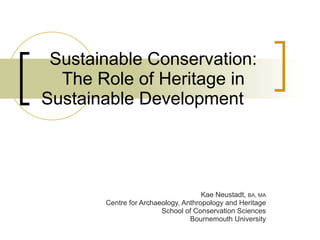Planning For The Past
- 1. Sustainable Conservation: The Role of Heritage in Sustainable Development Kae Neustadt, BA, MA Centre for Archaeology, Anthropology and Heritage School of Conservation Sciences Bournemouth University
- 2. Heritage, History and Archaeology Different meaning to different people, linked by a concern for the past. Little understanding of the differences between preservation, conservation and management. Training in ĄŪHeritageĄŊ often focuses on museum studies and tourism. Diversity of needs requires both generic and specific skills.
- 3. Who works in Heritage? Archaeologists Architectural Historians/ Historic Architects Landscape Architects Planners Curators Museum and Tourism specialists
- 4. What does Heritage have to do with Sustainability? Ą° Delivering Sustainable Communities by Putting the Historic Environment at the Heart of an Effective Planning SystemĄą* Focus for regeneration and economic development Maintenance of local distinctiveness and a sense of place. * From Heritage Protections for the 21 st Century (DCMS)
- 5. Archaeology: Learning and Doing Learning Archaeology Archaeology as Science GIS Chemical analysis Artefact analysis Conservation Archaeology as a Humanity Anthropological archaeology Culture and geography Theory and perception Law, policy and guidance
- 6. What is Archaeology? Learning and Doing Doing Archaeology Desk-based assessment Geophysical surveys Report writing Planning and management advice Budgets and contracts Communication with non-archaeologists
- 7. Archaeological Qualifications: Job skills training or liberal education? Most individuals gaining degree qualifications in archaeology will not make a career in the field. Ą° There is no common or core group of competencies that could be said to be essential for everyone entering the professionĄą* Should archaeology teach about the past or the present? From Archaeology Labour Market Intelligence: Profiling the Profession 2007-2008
- 8. Heritage: Museums, Art and Artefact Most training in Ą°HeritageĄą focuses on museum studies, tourism or conservation of materials. Training and coursework in planning limited to those seeking qualifications as ĄŪplannersĄŊ Greater need for interdisciplinary approaches to heritage and planning.
- 9. Conservation and Heritage Planning New PPS15 focuses on plan-making and the incorporation of historic environment evidence within the planning system. Requires a greater understanding of the planning system by heritage professionals and of heritage by planning professionals.
- 10. Key Issues: Significance PPS15 has Ą°at heartĄpolicies that protect the significance of heritage assets. A clear understanding of significance is therefore central to good decision-making.Ąą* English HeritageĄŊs Conservation Principles provide detail on the concept of significance and its component values. However, significance is also seen as an issue of degree, based on the individual judgement of the person perceiving a particular place. CONFLICT: How to assess and assign significance if it is always subjective and individual? *PPS15, 1.6
- 11. Key Issues: Assessing Impact Impact cannot be assessed without understanding the significance of the heritage asset. Impacts may be positive, negative or neutral. CONFLICTS: Whose ideas of significance get promoted? Who decides what is negative, positive or neutral? How to prevent an all-or-nothing approach?
- 12. Making Decisions about the Historic Environment Planners who make decisions regarding impacts to the historic environment need an understanding of how heritage assets are evaluated for significance and how impacts can be assessed. Archaeologists and heritage professionals who provide information to planners must understand the types of decisions required and how their expertise will be used to inform those decisions. We canĄŊt leave the decision-making to someone else and expect mutually acceptable solutions.
- 13. Making it Work Develop processes for identifying significant characteristics of heritage assets and ways in which to evaluate proposed impacts and change. Work together to cross-train for better understanding of both heritage and planning issues. Teach critical thinking, decision-making and communication alongside traditional subjects. Complex resources require complex thinking!
- 14. THANK YOU













